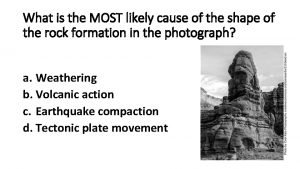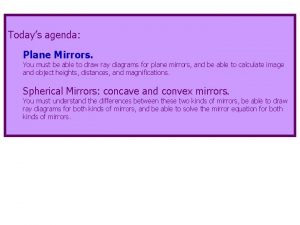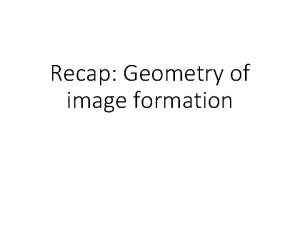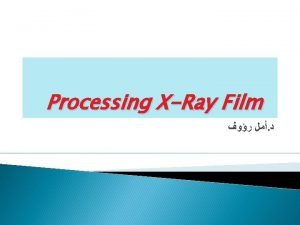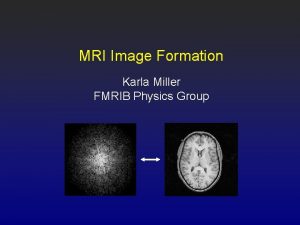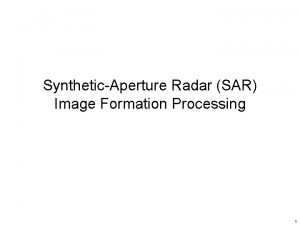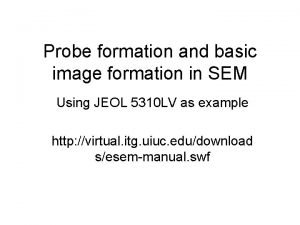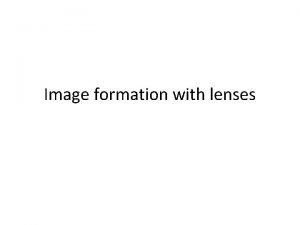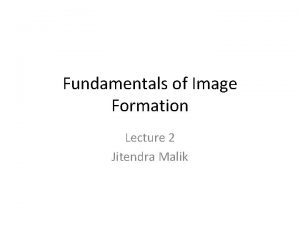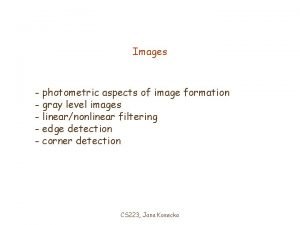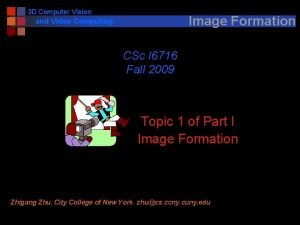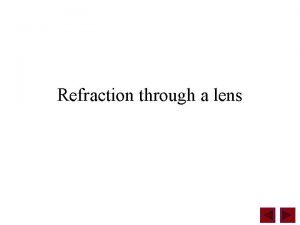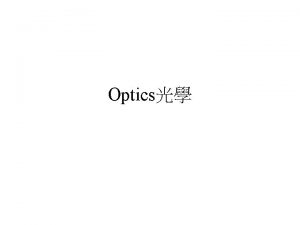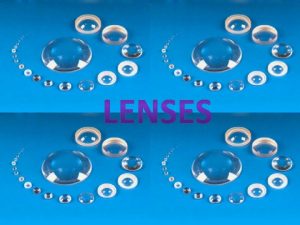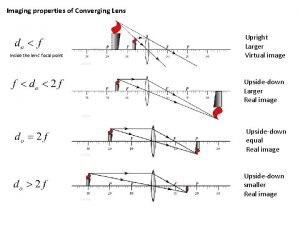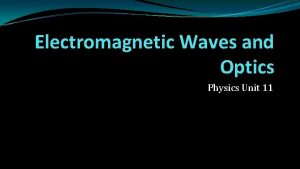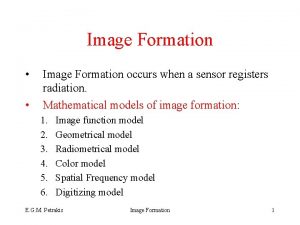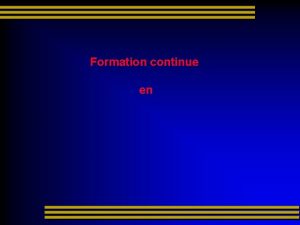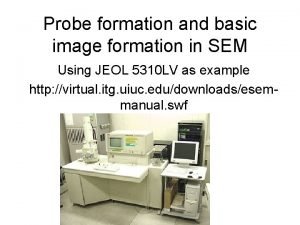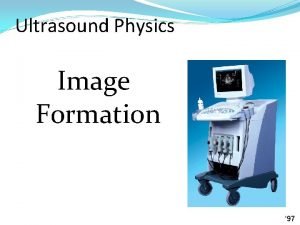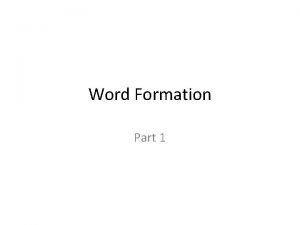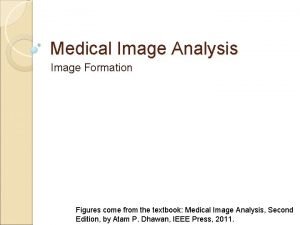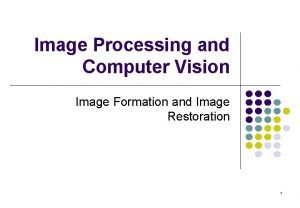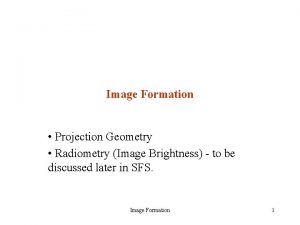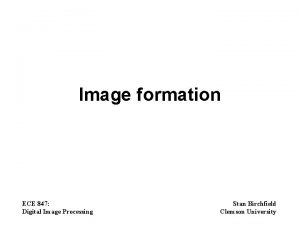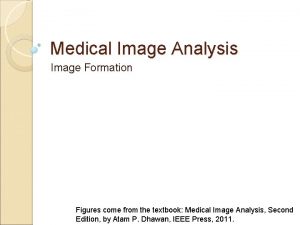Part II 1 Image Formation What is image































- Slides: 31


Part II. 1 Image Formation

What is image formation? Define the spatial location of the proton pools that contribute to the MR signal.

Steps in 3 D Localization • Can only detect total RF signal from inside the “RF coil” (the detecting antenna) Excite and receive Mxy in a thin (2 D) slice of the subject The RF signal we detect must come from this slice è Reduce dimension from 3 D down to 2 D è Deliberately make magnetic field strength B depend on location within slice Frequency of RF signal will depend on where it comes from è Breaking total signal into frequency components will provide more localization information è Make RF signal phase depend on location within slice

RF Field: Excitation Pulse Fo 0 t FT Time Fo Fo+1/ t Frequency Fo t FT Fo F= 1/ t

Gradient Fields: Spatially Nonuniform B: • Extra static magnetic fields (in addition to B 0) that vary their intensity in a linear way across the subject è Precession frequency of M varies across subject • This is called frequency encoding — using a deliberately applied nonuniform field to make the precession frequency depend on location 60 KHz Center frequency [63 MHz at 1. 5 T] Left = – 7 cm f Gx = 1 Gauss/cm = 10 m. Tesla/m = strength of gradient field x-axis Right = +7 cm

Spin phase with x gradient on x

Spin phase with y gradient on y

Exciting and Receiving Mxy in a Thin Slice of Tissue Excite: Source of RF frequency on resonance Addition of small frequency variation Amplitude modulation with “sinc” function RF power amplifier RF coil

Exciting and Receiving Mxy in a Thin Slice of Tissue Receive: RF coil RF preamplifier Filters Analog-to-Digital Converter Computer memory

Slice Selection

Slice Selection – along z z

Determining slice thickness Resonance frequency range as the result of slice-selective gradient: F = g. H * Gsl * dsl The bandwidth of the RF excitation pulse: w/2 p Thus the slice thickness can be derived as dsl = w / (g. H * Gsl * 2 p)

Changing slice thickness There are two ways to do this: (a) Change the slope of the slice selection gradient (b) Change the bandwidth of the RF excitation pulse Both are used in practice, with (a) being more popular

Changing slice thickness new slice thickness

Selecting different slices In theory, there are two ways to select different slices: (a) Change the position of the zero point of the slice selection gradient with respect to isocenter (b) Change the center frequency of the RF to correspond to a resonance frequency at the desired slice F = g. H (Bo + Gsl * Lsl ) Option (b) is usually used as it is not easy to change the isocenter of a given gradient coil.

Selecting different slices new slice location

Readout Localization (frequency encoding) • After RF pulse (B 1) ends, acquisition (readout) of NMR RF signal begins – During readout, gradient field perpendicular to slice selection gradient is turned on – Signal is sampled about once every few microseconds, digitized, and stored in a computer • Readout window ranges from 5– 100 milliseconds (can’t be longer than about 2 T 2*, since signal dies away after that) – Computer breaks measured signal V(t) into frequency components v(f ) — using the Fourier transform – Since frequency f varies across subject in a known way, we can assign each component v(f ) to the place it comes from

Readout of the MR Signal Constant Magnetic Field w/o encoding Varying Magnetic Field w/ encoding

Readout of the MR Signal Fourier Transform

A typical diagram for MRI frequency encoding: Gradient-echo imaging Excitation Slice Selection TE Frequency Encoding digitizer on Readout

Phase History TE Gradient Phase digitizer on

A typical diagram for MRI frequency encoding: Spin-echo imaging Excitation Slice Selection TE Frequency Encoding digitizer on Readout

Phase History 180 o Gradient Phase TE

Image Resolution (in Plane) • Spatial resolution depends on how well we can separate frequencies in the data V(t) – Resolution is proportional to f = frequency accuracy – Stronger gradients nearby positions are better separated in frequencies resolution can be higher for fixed f – Longer readout times can separate nearby frequencies better in V(t) because phases of cos(f t) and cos([f+ f] t) will be more different

Calculation of the Field of View (FOV) along frequency encoding direction g* Gf * FOVf = BW, where BW is the bandwidth for the receiver digitizer.

The Second Dimension: Phase Encoding • Slice excitation provides one localization dimension • Frequency encoding provides second dimension • The third dimension is provided by phase encoding: – We make the phase of Mxy (its angle in the xy-plane) signal depend on location in the third direction – This is done by applying a gradient field in the third direction ( to both slice select and frequency encode) – Fourier transform measures phase of each v(f ) component of V(t), as well as the frequency f – By collecting data with many different amounts of phase encoding strength, can break each v(f ) into phase components, and so assign them to spatial locations in 3 D

A typical diagram for MRI phase encoding: Gradient-echo imaging Excitation Slice Selection Frequency Encoding Phase Encoding digitizer on Readout

A typical diagram for MRI phase encoding: Spin-echo imaging Excitation Slice Selection Frequency Encoding Phase Encoding digitizer on Readout

Calculation of the Field of View (FOV) along phase encoding direction g* Gp * FOVp = Np / Tp where Tp is the duration and Np the number of the phase encoding gradients, Gp is the maximum amplitude of the phase encoding gradient.

Multi-slice acquisition Total acquisition time = Number of views * Number of excitations * TR Is this the best we can do? Interleaved excitation method
 Steps in digital image processing
Steps in digital image processing Formation initiale vs formation continue
Formation initiale vs formation continue Most likely cause
Most likely cause Paraxial
Paraxial Geometry of image formation
Geometry of image formation Latent image definition
Latent image definition Image formation mri
Image formation mri Jacobs cameras
Jacobs cameras Image formation by convex lens
Image formation by convex lens A model of destination image formation
A model of destination image formation Gurney mott theory of latent image formation
Gurney mott theory of latent image formation Geometric and photometric image formation
Geometric and photometric image formation Sar image formation
Sar image formation Image formation in sem
Image formation in sem Formation of image through narrow holes
Formation of image through narrow holes The principle involved in the image formation by lenses
The principle involved in the image formation by lenses Image formation outline
Image formation outline Fundamentals of image formation
Fundamentals of image formation Photometric image formation
Photometric image formation Fundamentals of image formation
Fundamentals of image formation Image formation computer vision
Image formation computer vision Digital image formation
Digital image formation Concave lens image formation
Concave lens image formation Convex lens image
Convex lens image Long-sightedness lens
Long-sightedness lens Converging lens image properties
Converging lens image properties Retina image formation
Retina image formation Physics 11-06 image formation by mirrors
Physics 11-06 image formation by mirrors Addition symbol
Addition symbol Unit ratio definition
Unit ratio definition Brainpop ratios
Brainpop ratios What is a technical description?
What is a technical description?


